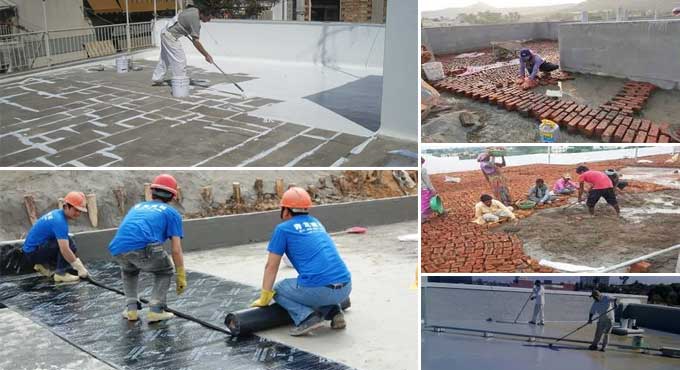
How to Waterproof a Terrace at Lowest Cost

Keeping the roof, floor, bathroom, and other wet areas from leaking is a big problem for every homeowner and contractor. It is common for leaks and seepage to occur on flat roofs because the water moves slowly or there is no slope for drainage.
You must first identify the cause of leakage or honeycombing in concrete in order to begin waterproofing.
Different Waterproofing methods for Terrace
Cementitious Waterproofing
Waterproofing chemicals and cement are used in this method. Most Indian homes are waterproof with this method.
Concrete slabs and concrete walls are the only structures that need a cemented waterproofing treatment. To make a waterproof slab or keep it leak-free, you must do Brickbat Coba. For the exhaust water to drain, Brickbat Coba is a convenient solution.
Chemical Waterproofing
A saw and scrubber use to clean the whole slab. The cracks and holes filled with cement grout. If there are any cracks or holes left after filling them, they should not be waterproof. Waterproofing the entire slab is brushing Polyurethane Chemicals on it. It was then left for 1 to 3 hours to dry. A terrace can be waterproof with this method.
In the drainage system and on the parapet walls 300 feet high, chemicals should apply. When the previous coat has dried, apply the second coat after 3 hours. Chemicals are also expensive with this method, despite its ease.
Which Chemical is best for waterproofing?
If there are grease and oily substances on the slab, make sure they remove before starting the process, as this could interfere with cement and chemicals setting on the slab.
When the slab cracks, there are holes and patches. Fill these with waterproofing chemicals, cement, and start the rest of the process.
Waterproofing chemicals such as acrylic additive, and 301 URP can use after cleaning the whole slab.
Follow the instructions on the bag for adding cement and stapling racks.
The slab should receive two coats of paint. Keep in mind that the second coat should be at an angle to the first. Let the coat dry for one day, and then mix the waterproofing chemical with the cement sand mortar in a ratio of 1: 4. The mixture should not exceed 10 mm thick.
Plastic Polythene
After completing brick masonry, the whole slab is supported by T-beams placed on top of brick masonry walls, and the distance between them is maintained. This type of slab is constructed in rural areas where the stone is cut according to width.
The final step is to place the stones on the beam. Large polythene or trampolines are positioned on the slab, & then the soil, brick tiles, and cement sand mix are laid on top of this to waterproof a slab.
Bitumen Waterproofing
The slab is then coated with bitumen, tar, or coal film after being thoroughly cleaned. An iron drum or other vessel is used to boil the bitumen first, after which it is carefully sprinkled over the slab.
A mesh is then laid on top of the bitumen before a second coating is applied by brush.
Conclusion
Waterproofing the terrace with cement is the best option. This method is simple, requires no skilled labor, is low-cost, durable, but takes a long time to complete.
In addition to the methods used to waterproof the roof, there are many other ways to waterproof the roof. The roof also comes in many types, and therefore their waterproofing will also differ.
A typical roof of an Indian house usually consists of wood, concrete, stone, iron T-beams, and gutter stones or concrete is well-known to everyone.
To learn more, watch the following video tutorial.
Video Source: Best Waterproofing Services & PSv Chemical Mfg.


